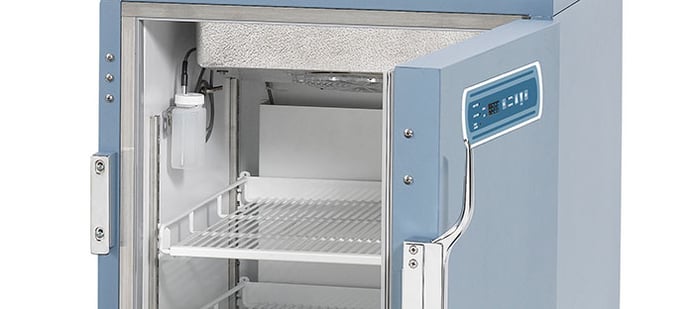
Researchers and practitioners know that stable storage temperature is important to ensure viability for frozen biological materials such as enzymes or vaccines, and that excessive time spent at out-of-range temperatures should be avoided. A common misconception is that auto-defrost freezers create an inappropriate environment for these laboratory materials compared to manual defrost freezers. We set out to evaluate the performance of both technologies by testing the impact of sample temperature viability during routine door openings and during the auto-defrost process, but first, let’s talk about the differences between manual defrost and auto-defrost technology.
Manual Defrost Technology
Manual defrost freezers use cold wall technology to maintain the cabinet’s temperature. This technology works by transferring the refrigerant to the cabinet walls through coils contained in the inner walls. This leads to the following:
- With every door opening, warm, moist air rushes to the coldest area inside the cabinet and immediately begins to build frost
- Frost must be removed routinely in order to maintain proper performance of the unit
- The unit must be taken out of service and allowed to defrost
- Stored items must be temporarily relocated, which exposes them to a temperature deviation
- Laboratories must always maintain multiple cold wall freezers to store product while the main unit defrosts
Auto-defrost Technology
Auto-defrost freezers use force air technology to maintain the cabinet’s temperature. Evaporator coils are located in an enclosed housing in the ceiling of the freezer versus inside of the walls. This technology works to eliminate frost build up by the following
- A fan circulates the cold air throughout the entire unit when the freezer is closed
- The cold air has a lower humidity level which forces any ice that has formed to evaporate without turning to a liquid
- When the freezer door is open, the fan shuts off to prevent warm air from circulating through the cabinet
- A heating element contained within the top housing automatically begins to heat the evaporator coils melting, draining, and then evaporating the frost
- Once the heat coils stop and cooling begins, the fan delays before re-activation to prevent the warm air that entered the cabinet from being circulated
Testing proved that the auto-defrost process of the Helmer Scientific -30ºC freezer is a more effective and efficient compared to a cold wall freezer’s manual defrost process. With minimal temperature fluctuation during the defrost cycle and quick recovery time after door opening, auto-defrost ensures the safe storage of frozen biological materials.
Not only are Helmer Scientific auto-defrost freezers the safest environment in which to store enzymes and vaccines, but this refrigeration system is also more efficient for the technicians and practitioners using them. Unlike manual defrost, auto defrost freezers eliminate the need for the tedious task of removing biological materials from the unit in order to melt the frost build-up, while subjecting them to temperature deviations in the process. Furthermore, without the need to remove materials stored in the freezer, there is also no need to purchase a second freezer to use as a holding zone until the original has been defrosted.




